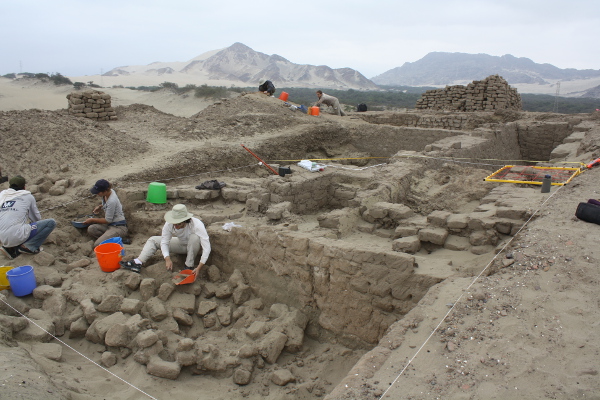Program Requirements
The following program requirements are based on the 2025–2026 Arts and Science Calendar. You must follow the program requirements of the year that you enrolled in the program. Program requirements from previous years can be found in previous Calendars.
PROGRAMS: Enrolment in the Specialist, Major and Minor programs is limited to students that meet the admission requirements. Please note that the admission requirements vary by program. See below for the admission requirements. Students may enrol at the end of First Year or at any later time if they meet the admission requirements.
- Program Description and Objectives
- Curriculum and Program Delivery
- Archaeology Specialist
- Archaeology Major
- Archaeology Minor
- Archaeology Course Groups
Program Description and Objectives

Archaeology is the study of past human societies based mainly on their material remains, or material culture. Archaeological research allows us to extend our understanding of history to include societies that existed many millennia before the advent of writing, as well as to societies and groups whose histories were never written down, or are known only partially.
Archaeologists explore continuity and change in past cultures around the world through field surveys, excavation of sites, and analyses of stone tools, pottery, bones, plant remains, architecture, and many other cultural residues. Some prominent fields of research are pursued almost exclusively through archaeology, such as research on the origins of agriculture and pastoralism, and on the origin of cities. But archaeologists also collect evidence about the lives of people and social groups who are misrepresented or not represented at all in conventional history, especially marginalized ethnic groups or classes. While some archaeologists focus on the prehistory of hunter-gatherers, others specialize in the study of politically complex societies.
Classical archaeologists, for example, specialize in the cultures of the ancient Greco-Roman world, and combine archaeological evidence with the rich textual sources that are available to them. Other archaeologists specialize in particular classes of evidence, such as paleoethnobotanists, who explore ways that botanical residues can inform us about ancient economies and social systems. Because archaeology is so diverse, and is pursued by faculty and students in several distinct departments, its curriculum is inherently interdisciplinary.
The Specialist, Major and Minor programs in Archaeology aim to provide students with an education in archaeology that meets the highest academic standards and allows them to develop their capacities to think clearly and critically, take account of a wide range of perspectives, make sound judgments, and contribute constructively to society.
The admission requirements aim to ensure students in the program are capable of acquiring a foundation in four-field anthropology or archaeology.
Curriculum and Program Delivery
The Archaeology Specialist program is a comprehensive program intended to give students the set of tools and breadth of background that they will require to pursue graduate studies in the field of archaeology or careers that involve understanding past civilizations and their material cultures. The program is designed to accommodate students with interests in diverse fields of specialization (e.g., Classical archaeology, Iroquoian archaeology and Palaeolithic archaeology).
In their first year, students take a foundational course in archaeology (ANT200Y) and one additional FCE selected from a variety of gateway courses in disciplines that underpin specialized fields of study in archaeology. Students in the Specialist also take a statistics course in preparation for subsequent courses that involve the analysis of quantitative archaeological data. In the upper years, students take core courses in archaeological theory, methods, and ethics.
Students in the Specialist also gain practical experience in lab and field settings. In the upper years, students also customize their program by choosing courses with specializations in particular research methodologies, cultural areas, or both.
Archaeology Specialist
(11.0 credits, including at least 4.0 credits at the 300+ level and 1.0 credit at the 400 level)
This is a limited enrolment program. All students who request the program and obtain at least the specified mark(s) in the required course(s) will be eligible to enrol.
Courses for admission: ARH100Y1 with a final mark of at least 70%.
First Year
1. ARH100Y1
2. Statistical Requirement: NMC268H1 or GGR270H1 (Geography pre- or co-requisites waived for Archaeology and Anthropology students); or 0.5 credit from STA220H1, STA221H1, STA247H1, STA248H1, STA255H1, STA257H1, STA261H1, or ANTC35H3 (at UTSC)
3. ANT100Y1 or CLA160H1. If CLA160H is taken, students must take an additional 0.5 credit from the following: CLA210H1, CLA230H1, CLA231H1; FAH206H1, FAH207H1; GGR101H1; NMC262H1
Upper Years
4. ARH205H1, ARH309H1, ARH312Y1, ANT411H1
5. Field Requirement: ANT311Y1 or ARH306Y1 or NMC261Y0 or ARH361Y1 or ARH361H1 or ANT418H5 (at UTM). If ARH361H1 or ANT418H5 is taken, students must take an additional 0.5 credit from ANT/ARH/JAL/JGA.
6. 5.0 credits from Group A and Group B, of which 2.0 credits must be from Group A and 2.0 credits must be from Group B and 1.0 credit from either group.
Note that students may substitute ARH495H1 (Research Practicum) for 0.5 credit of this requirement (assignment to Group A or B to be determined by Undergraduate Coordinator).
Archaeology Major
(7.0 credits, including at least 2.0 credits at the 300+ level and 0.5 credit at the 400-level)
This is a limited enrolment program. All students who request the program and obtain at least the specified mark(s) in the required course(s) will be eligible to enrol.
Courses for admission: ANT100Y1 or ARH100Y1 with a final mark of at least 65%.
First Year:
1. ARH100Y1
2. ANT100Y1 or CLA160H1. If CLA160H1 is taken, students must take an additional 0.5 credit from the following: CLA210H1, CLA230H1, CLA231H1; FAH206H1, FAH207H1; GGR101H1; NMC262H1
Upper Years
3. ARH205H1 and ARH309H1
4. 1.0 credit from: ARH306Y1, ARH312Y1, ARH361Y1, ARH361H1, ANT311Y1, NMC261Y0, NMC465H1, NMC466H1
5. 2.5 credits from: Group A
6. 0.5 credit from: Group B
Archaeology Minor
(4.0 credits, including at least 1.0 credit at the 300- or 400-levels)
This is a limited enrolment program. All students who request the program and obtain at least the specified mark(s) in the required course(s) will be eligible to enrol.
Courses for admission: ARH100Y1 with a final mark of at least 65%.
1. ARH100Y1
3. 1.5 credits from Group A
4. 0.5 credit from Group B
If ARH312Y is completed, it will be considered a Group A course.
Archaeology Course Groups
(Note that these are different from the Anthropology course groups that include archaeology.)
The groups are divided in such a way as to give you guidance about which courses, in various departments, are relevant to different areas of archaeological specialization. Note that this does not mean that they are archaeology courses, per se.
These groups fulfill requirements for the archaeology programs.
GROUP A: Theoretical and Methods
- Theoretical: ANT210H1, ANT215H1, ANT325H1, ANT370H1, ANT409H1, ANT410H1, ANT411H1, ANT416H1, ANT420H1; GGR274H1; NMC265H1, NMC266H1, NMC268H1, NMC474H1, NMC476H1; MCS225Y1
- Archaeometry: ARH440H1, CHM317H1, CHM414H1, CHM416H1; GGR315H1; JGA305H1; NMC462H1, NMC470H1
- Ceramic and Lithic Analysis: ANT406H1, ANT408H1; FAH205H1, NMC465H1, NMC466H1, NMC469Y1
- Geoarchaeology: ANT409H1; GGR272H1, GGR273H1, GGR301H1, GGR315H1, GGR373H1, GGR390H1, GGR406H1, GGR413H1; ESS234H1, ESS331H1; JGA305H1
- Osteoarchaeology and Zooarchaeology: ANT334Y1, ANT335Y1, ANT 338H1, ANT415Y1, ANT434H1; EEB318H1, EEB323H1, EEB324H1, EEB390H1
- Paleoethnobotany: EEB340H1; GGR305H1, GGR390H1; JGE331H1
- Urbanism and Settlement: ANT 318H1
GROUP B: Area Courses and Cultural History
- Classical and Aegean Archaeology: CLA210H1, CLA215H1, CLA230H1, CLA231H1, CLA362H1, CLA363H1, CLA364H1, CLA367H1, CLA368H1, CLA369H1, CLA372H1, CLA373H1, CLA389H1, CLA392H1, CLA402H1, CLA403H1; FAH206H1, FAH207H1, FAH303H1, FAH309H1, FAH401H1, FAH407H1, HIS320H1
- Egyptian Archaeology: JAL328H1; NMC267H1, NMC343H1, NMC345H1, NMC344H1, NMC365H1, NMC367H1, NMC368H1, NMC461H1, NMC467H1, NMC468H1
- European and Celtic Archaeology: FAH318H1, FAH327H1, FAH328H1, FAH420H1, FAH421H1; HIS321H1, HIS323H1, HIS403H1, HIS424H1, HIS432H1
- Historical Archaeology: ANT405H1, ANT412H1, GGR240H1, GGR336H1, GGR421H1; HIS369H1
- Islamic Archaeology: NMC376H1, NMC394H1
- Near Eastern Archaeology: JAL328H1; NMC260H1, NMC262H1, NMC264H1, NMC346H1, NMC347H1, NMC360H1, NMC361H1, NMC364H1, NMC366H1, NMC369H1, NMC370H1, NMC380H1, NMC445H1, NMC446H1, NMC449H1, NMC477H1, NMC461H1, NMC463H1, NMC464H1, NMC466H1, NMC471H1, NMC491H1
- North and South American Prehistory: ANT315H1, ANT317H1, ANT320H1, ANT407H1; JIH369H1; JIG322H1
- Old World Prehistory: ANT419H1; ARH360H1
- East Asian Archaeology: EAS312H1, EAS412H1


